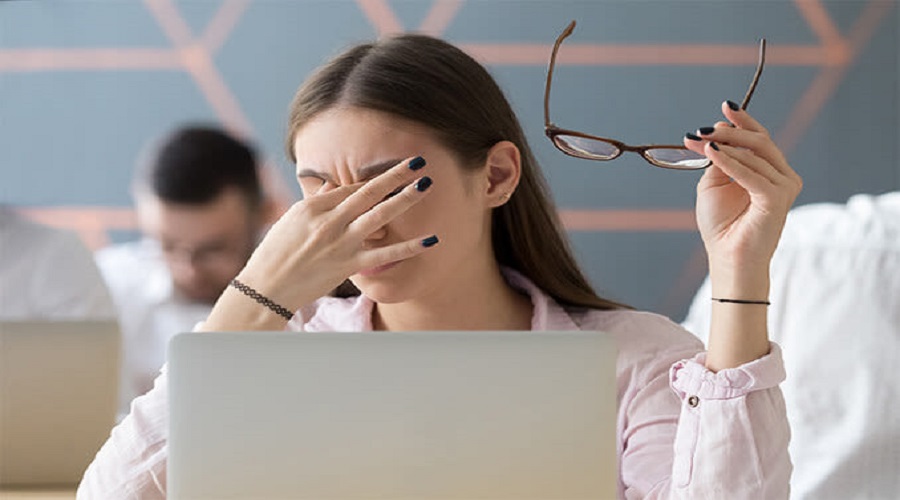- March 3, 2022
- No Comment
- 158
5 Easy Ways to Keep Your Eyes Free of Screentime Straining

Whether you work on a computer or use your phone during your time off, your eyes probably get hours of screen time each day. If you’ve begun to get neck pain, headaches, dry and tired eyes, or blurry vision, you’re beginning to show signs of digital eye strain. It’s harder to develop this condition if you use prescription computer glasses, but beating it requires changing your attitude towards looking at your devices.
While digital eye strain is annoying and painful, it does not have to be permanent. Here are five easy but effective ways to relax your eyes and head while you look at screens.
1. Think About Your Lighting
If you spend hours looking at a screen while surrounded by extremely bright lights, your risk of digital eye strain increases. It’s hard for your eyes to take so much exposure to light, even if you’re relying on natural light.
For best results, turn off your fluorescents lights, especially ones that are above you, and rely on smaller lamps with LED bulbs. Close your blinds or curtains to eliminate exterior light entry, and if that’s not possible, put your computer to the side of your windows. Sitting directly behind or in front of a window increases the glare on your screen and makes you squint, aggravating your digital eye strain symptoms.
You also need to think about the light your computer emits. Use your settings to lower your computer’s color temperature so that your display appears more orange than blue. Turn down your brightness until it matches your ambient lighting, but be careful not to make your screen so dark that you have to strain to see.
2. Talk to Your Eye Doctor
Whether or not you need prescription computer glasses, visiting your eye doctor once per year is a necessity, especially if you have digital eye strain. You may have myopia or another eye condition that is worsening your eye fatigue without your knowledge. Also, digital eye strain symptoms can sometimes indicate more serious health problems, so list everything you’re experiencing to your eye doctor.
When your doctor asks if you have questions, tell him or her how many hours you spend looking at screens and ask what you can do to protect your eyes. Before you leave, don’t forget to order your glasses or contact lenses if your eyesight has deteriorated.
3. Purchase Blue Light Glasses
Blue light glasses are similar to safety glasses in that they keep dangerous substances from reaching your eyes. With blue light glasses, though, you’re less worried about flying debris and more worried about the light your screens emit. Depending on their tint, these glasses block between 5 and 100 percent of blue light rays. If you just need a little relief, buying clear blue light glasses should be sufficient; if you have severe digital eye strain, yellow- or red-tinted glasses provide more protection.
Depending on your needs, you can get prescription computer glasses or ones without prescription lenses. The second option is a good choice if you wear contact lenses that dry out when you stare at a screen for hours.
Investing in blue light glasses not only reduces your digital eye strain symptoms but also helps you sleep better. Studies suggest that blue light interferes with your Circadian rhythms, which are your natural patterns of waking and sleeping. If you’ve been struggling with insomnia, a problem that can worsen your symptoms, wearing blue light glasses can get your sleep cycle back on track.
4. Move Your Eyes
Even if you’re wearing protective lenses, it’s not a good idea to continually stare at your screen while you work. If your eyes are starting to burn or dry out, find an object that’s more than 20 feet away, look at it for 10 seconds, and then look at something on your desk (not your computer or phone) for 10 seconds. Repeat the process 10 times to get your eyes accustomed to moving around again and prevent accommodative spasms.
For an eye exercise you can do throughout your day, every 20 minutes, look at an item that is 20 feet or more away for 20 seconds. This technique gives your eyes’ focusing muscles a break and practices your long-distance eyesight, which often suffers when you’re working on a computer.
Another key eye movement that’s easy to forget about is blinking. Studies suggest that you blink two-thirds less frequently when you’re looking at a screen than when you’re walking around or talking to someone. When you don’t blink normally, your tears evaporate and your tear ducts can’t replace them quickly enough, leading to dry eyes.
After completing your eye movement exercises every 20 minutes, blink 10 times as slowly as possible to give your tears a chance to collect. For severe dry eye issues, talk to your eye doctor about eye drops that you can insert when your eyes start getting red or itchy.
5. Step Away From Your Devices
While there are many ways to reduce eye fatigue while you’re working, you also have to step away from your screens sometimes. If possible, spend 10 minutes of each hour away from your screens. Schedule your phone calls and meetings strategically so you can give your eyes a rest as you talk to clients and coworkers. If you normally ask your receptionist to make copies, start performing this task yourself so that you’re completely removed from your screen.
When possible, move your entire body as you take your screen breaks. Get up from your desk and stretch each area:
- Legs
- Glutes
- Abs
- Arms
- Shoulders
- Back
- Neck
When you’re stretching, your eyes don’t have to do much, so your focusing muscles can relax. Also, sometimes digital eye strain headaches result from carrying too much tension in your body, so releasing stress regularly is critical.
It’s hard to avoid hours of screentime, so taking care of your eyes has never been more important. Follow these tips to reduce eye strain symptoms, and prevent future problems by browsing the collection of blue light glasses at Safety Gear Pro.





